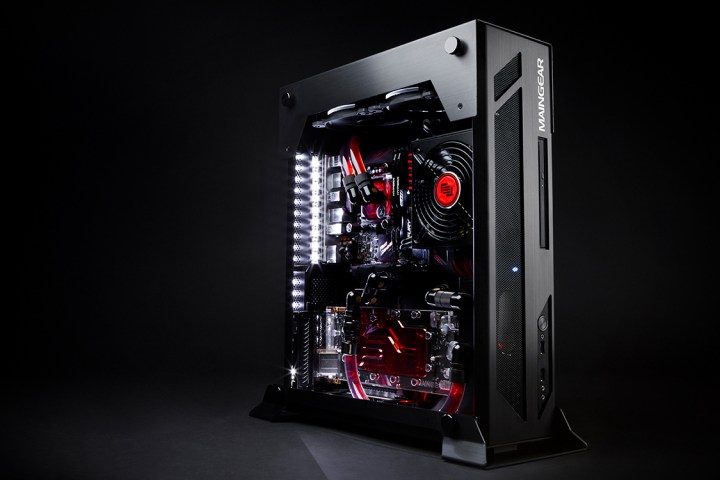
In addition to the processor and the GPU, the updated Drift gaming machine supports all Mini ITX platforms including Z170 and X99. It also supports up to 32GB of DDR4 memory, Intel 750 Series and Samsung 950 Pro NVMe SSDs, the company’s Epic Superstock full-liquid cooling, and its Redline CPU and GPU overclocking. The machine can even come with Windows 10 or Valve Software’s open-source operating system, SteamOS, making it a certified Steam Machine.
If you go for the cheapest Drift configuration the company offers, the base setup consists of an Asus Z170I Pro motherboard with an Intel Core i3-6100 dual-core processor cooled by Maingear’s Intel-certified cooler. The system also comes with 8GB of HyperX Fury dual-channel DDR4 memory clocked at 2,666MHz, an AMD Radeon R7 360 graphics card with 2GB of on-board memory, and a 1TB hard drive from Seagate. All of this is powered by a 450-watt Corsair SF450 80 Plus Gold Certified power supply.
The most expensive configuration of Maingear’s four starting points begins at a meaty $4,399. This base setup has an ASRock X99E-ITX motherboard stuffed with a liquid-cooled Intel Core i7-6800K six-core processor, 8GB of HyperX Fury DDR4 dual-channel memory clocked at 2,666MHz, AMD’s Radeon RX 480 graphics card with 8GB of on-board memory, and a 1TB hard drive provided by Seagate. Despite is hardware, it’s still powered by a 450-watt Corsair SF450 80 Plus Gold Certified power supply.
As previously stated, the updated Drift desktop supports the ten-core Intel Core i7-6950X processor with a base clock of 3GHz, and a turbo clock of 3.5GHz. Other processors customers can choose from include the Intel Core i7-6850K six-core processor with a base clock of 3.6GHz and a turbo clock of 3.8GHz, and the Intel Core i7-6900K eight-core processor with a base clock of 3.2GHz and a turbo clock of 3.7GHz.
On the graphics front, the Nvidia-based GPU selection consists of the GeForce GTX 1080 card with 8GB of on-board memory, and the GeForce GTX 1070 Founders Edition with 8GB of on-board memory. On the AMD front, choices include the Radeon Pro Duo 8GB card and the Radeon R9 Fury X 4GB card tuned for virtual reality.
Nvidia’s new Titan X graphics card, now offered as a selection when customizing the Drift desktop, is based on the company’s latest Pascal architecture. It consists of 3,584 CUDA cores with a base clock speed of 1,417MHz and a boost clock speed of 1,531MHz. It also has 12GB of GDDR5X memory, a memory bandwidth of 480GB per second, a memory speed of 10Gb per second, and a 384-bit memory interface. It’s the company’s fastest card to date, cranking out 11 TFLOPs of sheer power.
For more information about the Maingear Drift gaming desktop, head here.
Editors' Recommendations
- Ubisoft, Tencent will begin using Nvidia’s AI-generated NPC tools
- AMD Ryzen 7 5800X3D shines in gaming benchmarks, beats Intel



